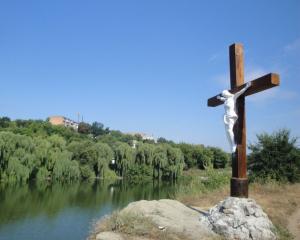Clergymen of UGCC and UOC-MP: Cross Installed in Place of Prayer for Hasidim Should Be Moved

![]()
 The three-meter oak cross with a crucifix that was installed in Uman in a place of prayer for the Hasidim should be moved to another location. This opinion is held by the clergymen of two denominations, the Ukrainian Greek Catholic Church (UGCC) and the Ukrainian Orthodox Church-Moscow Patriarchate (UOC-MP), who participated in the cross’s consecration. They also agree with the idea that the religious Christian symbol may lead to conflicts between locals and Jews.
The three-meter oak cross with a crucifix that was installed in Uman in a place of prayer for the Hasidim should be moved to another location. This opinion is held by the clergymen of two denominations, the Ukrainian Greek Catholic Church (UGCC) and the Ukrainian Orthodox Church-Moscow Patriarchate (UOC-MP), who participated in the cross’s consecration. They also agree with the idea that the religious Christian symbol may lead to conflicts between locals and Jews.
The pastor of the Cathedral of the Holy Virgin of the Ukrainian Greek Catholic Church, Father Dmytro Baley, whom RISU asked for a comment, said that he was invited by local Cossacks to the consecration of the cross.
“The organizers told me that it would be an interfaith event, that everything was already arranged. On Saturday, at 10 o'clock, they called and asked me to come in an hour, and said where,” said the priest.
Father Baley is new to Uman. The fact that the cross was placed in a place of prayer for the Hasidim he did not know.
“I haven’t been in Uman long enough to know that the consecration will take place at a site of conflict. There were some suspicions, but I was not alone at the place of consecration, for a priest of the UOC-MP also came, the pastor of the Holy Protection Church, Father Andriy. He has been here longer,” said the priest.
According to the UGCC priest, in Uman there is now a discussion on what to do with the Christian symbol: to move it or not. The installation of the cross, as has been reported, has provoked a series of protests from the Jewish community. Moreover, soon thousands of pilgrims will come to Uman, among them may be different people, and it is possible that someone will become outraged. Father Baley therefore is convinced that the best way out of this situation is to move the cross elsewhere. The priest also said that people who were involved in the installation of the cross were not guided by Christian motives, but by political, mercantile ones.
“The authorities asked whether we minded that it would be moved. I said that we have nothing against it. However, our church is in the minority here, so the final decision is not ours,” said the UGCC priest.
A representative of the UOC-MP is also for moving the cross with crucifix. Archbishop of Uman and Zvenyhorod Panteleimon (Baschuk) in a comment to Press Center said that he was not invited to participate in the consecration and was not even asked for his blessing. He said the cross should stand elsewhere and should unite, not divide people.
“I did not participate in the consecration of the cross, I was not invited. Moreover, I was never asked for my blessing or advice. Had they asked, I would have advised to put the crucifix somewhere else. The cross should unite people and not cause quarrels. Usually crosses are placed at the entrance to a city, at a crossroads, or in memory of something. The pond near the Jewish synagogue is not a place for commemoration. The cross has to stand in place that is accessible for people, not near rocks, which makes it difficult to reach. I am convinced that the people who installed it should listen to the advice of the local authorities and move it to another place,” said Bishop Panteleimon.
As was reported, Chief Rabbi of Kyiv and Ukraine, President of the Association of Jewish Organizations of Ukraine, and member of the All-Ukrainian Council of Churches and Religious Organizations Yaakov Dov Bleich said the installation of a cross in the place of prayer for Hasidim in Uman is a provocation, and hoped that the Ukrainian authorities will understand and solve this problem.
“Ukraine is not a Jewish country and Jews respect Christian symbols, like crosses, that are installed on Ukrainian soil. However, the cross in Uman, in the vicinity of the tomb of Rabbi Nachman, is a clear provocation,” the news site Kyiv Yevreyskyj (Kyiv Jewish) quotes the chief rabbi of Ukraine as saying.









